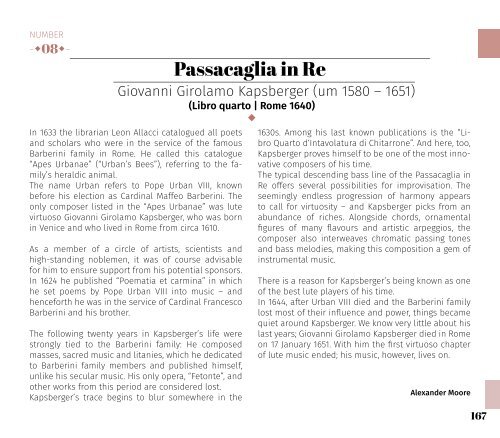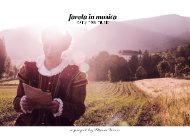Booklet "favola in musica.alte neue musik"
Enjoy the 216 pages fairy tale book inspired booklet of "favola in musica. early new music" in German and English with over 100 photographs, well researched musical texts to each aria, translations of all aria texts in German and English and biographies of all participating members. Music from renaissance, baroque and present time - 3 world premiere recordings from early music (Antonio Caldara, Sebastian Durón) - 2 world premiere recordings of contemporary music (Wolfgang Mitterer) - 1 bonus music-video (included on the CD) Deluxe Edition in a high-quality CD-Hardcover-Digibook, 216 costly designed pages with photos and texts 1607. ensemble for early & new music: Maria Weiss, voice, artistic director Rosario Conte, theorbo Gyöngy Erödi, cello Wolfgang Mitterer, composer Awarded the Pasticciopreis 2015 in Radio Österreich 1 »favola in musica« (eng. fairy tale in music) is the debut-album of the mezzo-soprano Maria Weiss, who designed this album as a musical fairy taie. It is the searching for the New within the Old and for the Old within the New. Developing this album,Maria Weiss lifted some treasures to light, so e.g. she discovered in the archives an aria of the forgotten opera of the composer Antonio Caldara. She also asked the composer and performer Wolfgang Mitterer, to reate two new works for this album. If you engage into this musical journey, you can also find the words of Monteverdis L'Orfeo but in an competely new contemporary way. Enjoy!
Enjoy the 216 pages fairy tale book inspired booklet of "favola in musica. early new music" in German and English with over 100 photographs, well researched musical texts to each aria, translations of all aria texts in German and English and biographies of all participating members.
Music from renaissance, baroque and present time
- 3 world premiere recordings from early music (Antonio Caldara, Sebastian Durón)
- 2 world premiere recordings of contemporary music (Wolfgang Mitterer)
- 1 bonus music-video (included on the CD)
Deluxe Edition in a high-quality CD-Hardcover-Digibook, 216 costly designed pages with photos and texts
1607. ensemble for early & new music:
Maria Weiss, voice, artistic director
Rosario Conte, theorbo
Gyöngy Erödi, cello
Wolfgang Mitterer, composer
Awarded the Pasticciopreis 2015 in Radio Österreich 1
»favola in musica« (eng. fairy tale in music) is the debut-album of the mezzo-soprano Maria Weiss, who designed this album as a musical fairy taie. It is the searching for the New within the Old and for the Old within the New. Developing this album,Maria Weiss lifted some treasures to light, so e.g. she discovered in the archives an aria of the forgotten opera of the composer Antonio Caldara. She also asked the composer and performer Wolfgang Mitterer, to reate two new works for this album. If you engage into this musical journey, you can also find the words of Monteverdis L'Orfeo but in an competely new contemporary way. Enjoy!
Erfolgreiche ePaper selbst erstellen
Machen Sie aus Ihren PDF Publikationen ein blätterbares Flipbook mit unserer einzigartigen Google optimierten e-Paper Software.
NUMBER<br />
-•08•-<br />
In 1633 the librarian Leon Allacci catalogued all poets<br />
and scholars who were <strong>in</strong> the service of the famous<br />
Barber<strong>in</strong>i family <strong>in</strong> Rome. He called this catalogue<br />
“Apes Urbanae” (“Urban’s Bees”), referr<strong>in</strong>g to the family’s<br />
heraldic animal.<br />
The name Urban refers to Pope Urban VIII, known<br />
before his election as Card<strong>in</strong>al Maffeo Barber<strong>in</strong>i. The<br />
only composer listed <strong>in</strong> the “Apes Urbanae” was lute<br />
virtuoso Giovanni Girolamo Kapsberger, who was born<br />
<strong>in</strong> Venice and who lived <strong>in</strong> Rome from circa 1610.<br />
As a member of a circle of artists, scientists and<br />
high-stand<strong>in</strong>g noblemen, it was of course advisable<br />
for him to ensure support from his potential sponsors.<br />
In 1624 he published “Poematia et carm<strong>in</strong>a” <strong>in</strong> which<br />
he set poems by Pope Urban VIII <strong>in</strong>to music – and<br />
henceforth he was <strong>in</strong> the service of Card<strong>in</strong>al Francesco<br />
Barber<strong>in</strong>i and his brother.<br />
The follow<strong>in</strong>g twenty years <strong>in</strong> Kapsberger’s life were<br />
strongly tied to the Barber<strong>in</strong>i family: He composed<br />
masses, sacred music and litanies, which he dedicated<br />
to Barber<strong>in</strong>i family members and published himself,<br />
unlike his secular music. His only opera, “Fetonte”, and<br />
other works from this period are considered lost.<br />
Kapsberger’s trace beg<strong>in</strong>s to blur somewhere <strong>in</strong> the<br />
Passacaglia <strong>in</strong> Re<br />
Giovanni Girolamo Kapsberger (um 1580 – 1651)<br />
(Libro quarto | Rome 1640)<br />
•<br />
1630s. Among his last known publications is the “Libro<br />
Quarto d‘Intavolatura di Chitarrone”. And here, too,<br />
Kapsberger proves himself to be one of the most <strong>in</strong>novative<br />
composers of his time.<br />
The typical descend<strong>in</strong>g bass l<strong>in</strong>e of the Passacaglia <strong>in</strong><br />
Re offers several possibilities for improvisation. The<br />
seem<strong>in</strong>gly endless progression of harmony appears<br />
to call for virtuosity – and Kapsberger picks from an<br />
abundance of riches. Alongside chords, ornamental<br />
figures of many flavours and artistic arpeggios, the<br />
composer also <strong>in</strong>terweaves chromatic pass<strong>in</strong>g tones<br />
and bass melodies, mak<strong>in</strong>g this composition a gem of<br />
<strong>in</strong>strumental music.<br />
There is a reason for Kapsberger’s be<strong>in</strong>g known as one<br />
of the best lute players of his time.<br />
In 1644, after Urban VIII died and the Barber<strong>in</strong>i family<br />
lost most of their <strong>in</strong>fluence and power, th<strong>in</strong>gs became<br />
quiet around Kapsberger. We know very little about his<br />
last years; Giovanni Girolamo Kapsberger died <strong>in</strong> Rome<br />
on 17 January 1651. With him the first virtuoso chapter<br />
of lute music ended; his music, however, lives on.<br />
Alexander Moore<br />
167





